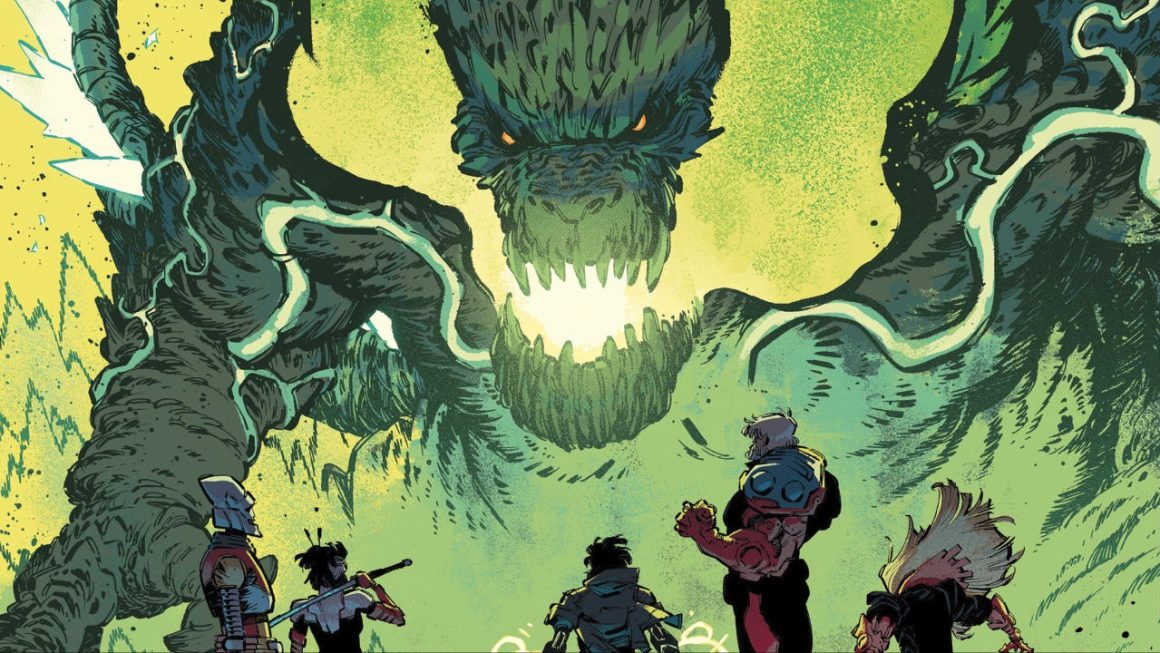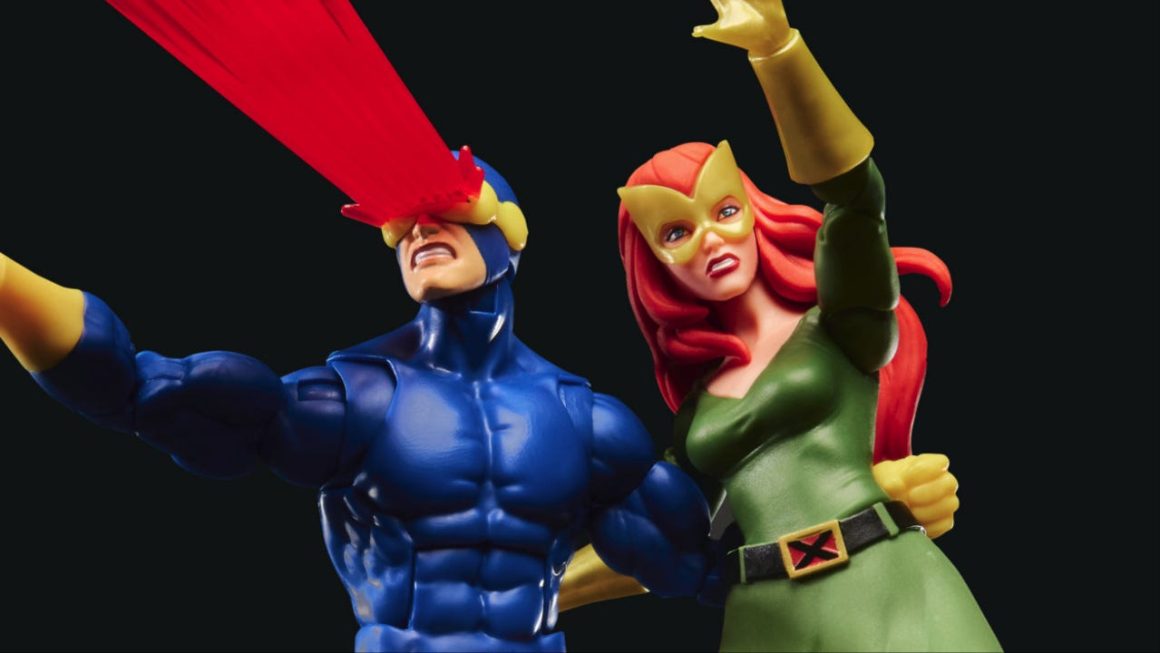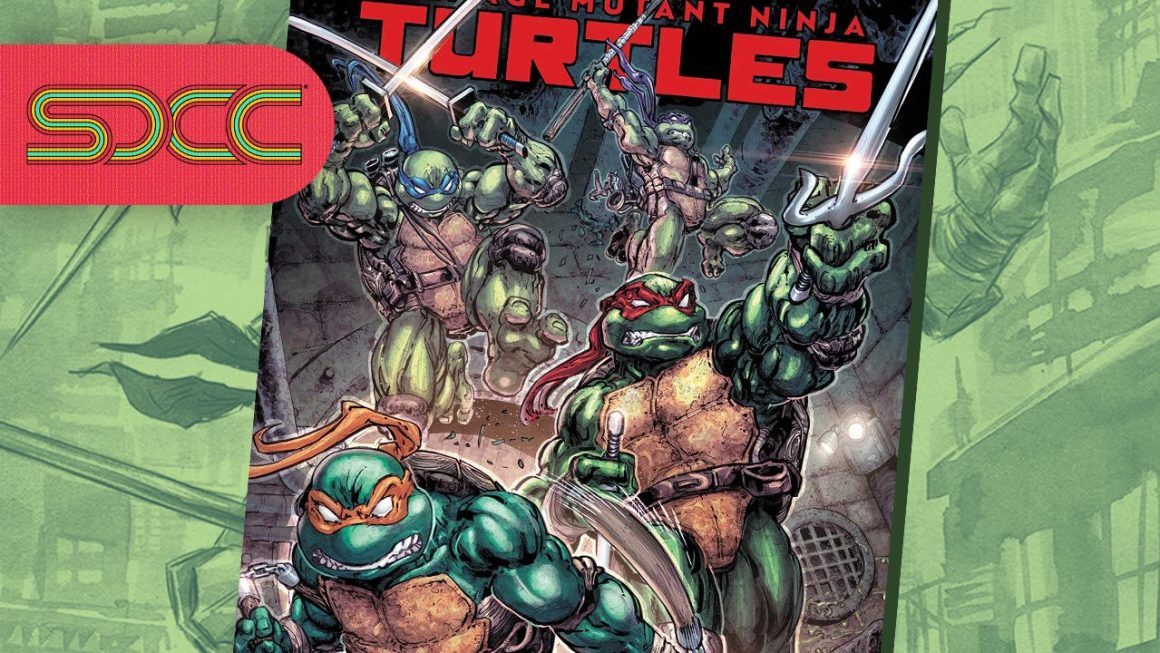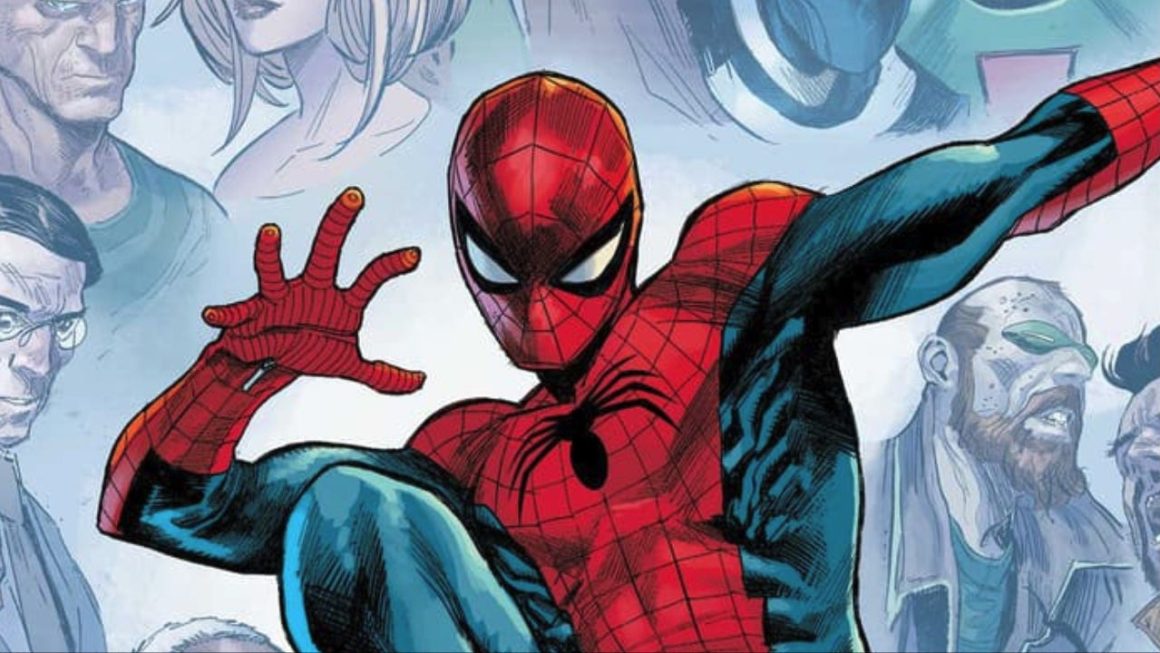The Godzilla franchise has become one of the core pillars of IDW’s line of licensed comics, standing alongside the likes of TMNT and Star Trek. And while they’ve certainly published plenty of Godzilla content over the years, it’s safe to say 2025 is their most ambitious year yet. With the release of Godzilla #1, IDW has officially kicked off a brand new shared universe known as the Kai-Sei Universe (named for the powerful energy source that fuels Godzilla and other kaiju).
This rebooted Godzilla line will consist of three monthly comics initially – Tim Seeley and Nikola Cizmesija’s Godzilla, Ethan Parker, Griffin Sheridan, and Pablo Tunica’s Godzilla: Escape the Deadzone, and Chris Gooch and Oliver Ono’s Starship Godzilla. Each book is very different in terms of cast, tone, and setting, but all fit into a larger puzzle in this universe where humanity has been dealing with kaiju attacks since 1954.
To learn more about how the Kai-Sei universe came to be and how these books fit together, IGN spoke with editor Jake Williams, as well as Seeley, Sheridan, and Ono. Read on to learn more about the Kai-Sei era of Godzilla.
Developing the Kai-Sei Universe
It’s probably natural to look at the Kai-Sei Universe and assume IDW is seeking to create its own version of Marvel’s Ultimate Universe or DC’s Absolute Universe. After all, both have proven wildly successful over the past couple of years, proving there’s a real demand for accessible, streamlined, and modernized takes on classic franchises. Williams and the creators revealed that while they weren’t necessarily inspired by the Ultimate Universe directly, the end goal is still the same.
“I think from a baseline perspective, when you’re making a new universe, those words are on your mind,” Williams tells IGN. “You’re thinking Ultimate Godzilla, you’re thinking Absolute Godzilla. And I think a lot of that is more of how you pitch it internally to the company. I think there’s less about the actual craft of the books that is hearkening back to those things. And it’s more about taking the ethos of the Ultimate Universe and being like, okay, let’s take everything we like about Godzilla or Spider-Man and let’s boil it down to something new and different. And have it be reflective of what’s going on in modern-day society.”
Seeley adds, “I don’t think that stuff specifically is an influence, but I think the idea of giving something familiar but accessible, that’s the job that should be every comic. It shouldn’t be if every superhero comic should be that really. It doesn’t have to be Absolute or Ultimate or anything. You’re trying to make something that the people who will already love it will, and the people who’ve never read it will. That’s the job. So we just treat it like every issue should be Absolute and Ultimate, and no matter where we come from with it.”
We were curious how the creators built out this shared universe. Was there a big editorial summit where the details were ironed out? Not quite, according to Williams. He purposely wanted to keep the books separated when starting out, allowing the connections between them to form gradually over time.
“With this universe specifically, it’s very purposefully sequestered off from each other at the starting point,” Williams says. “And that allows Tim to tell the story that he wants to tell, and allows Oliver and Chris tell the story they want to tell. And it lets Griffin and Ethan and Pablo to tell their story. And all these different things are kind of cooking on their own right now to kind of come in later. So the Starship Godzilla is way off in space. That’s the farthest one”.
Williams continues, “When Tim and Ethan and Griffin were all officially signed on, we had a big meeting together to just establish the nature of the Deadzone. And kind of establish a rough timeline of how long has this been here? How does that affect Tim’s characters? How does that affect Ethan and Griffin and Pablo’s characters? And just getting that kind of out in a rough way. But other than that, they just kind of go and I’m there to once in a while be like, ‘Oh no, sorry, this book actually said this, so we probably need to get aligned that way.’”
These books being so different in terms of tone and focus speaks to the malleability of the Godzilla franchise as a whole. The movies themselves can be wildly different, so why not the comics?
“There’s also such a long history of Godzilla stuff, having different tones and stories, the original movies [being] a somber reflection on atomic war,” Seeley says. “Then you get to the mid-’70s stuff where it’s just completely a kid’s thing and Godzilla talks and does kung-fu and s***. So there’s so much room in there that even if ours are totally different, it’s not, that’s not something well established within the existing stories.”
Sheridan teases an upcoming Godzilla crossover, revealing that he’s looking forward to seeing the three titles intersect and highlighting those differences.
“The crossover is going to be sweet,” Sheridan says. “I think what we have right now is we want to make sure that these books can all read independently. And to make sure that, first and foremost, we’re making great comic books for people who want to read great comic books. And then, of course, people who want to read interesting Godzilla stories, that’s obviously a crucial part of the mission as well. But it’s not like you absolutely have to be reading all three, right?
Sheridan adds, “I think what the benefit of reading all three is that that is what gives you the greater idea of the tapestry, of the whole picture, of the whole universe. Where we don’t want to bog you down in the minutia of a shared universe. We just want the cool parts. And so when you read all three titles, you get a really clear picture of what the Kai-sei universe is without being lost narratively, which I think is really great.”
Ultimately, the idea with the Kai-Sei universe isn’t so different from that of IDW’s relaunched Star Trek line. They want to take full advantage of the comic book medium and tell Godzilla stories that couldn’t be done in any other format.
“I don’t want licensed comics or comics with a big IP to feel secondary,” Williams says.” I don’t think there’s any reason they should. And I think that when people make comics just to be poor reflections of a film or TV show, it feels like as a medium, as an industry, we’re bowing down to these other mediums that I don’t think have on us, and that upsets me. So instead, I think we use comics and what that gives us to make things that are cooler and better and different and weird and exciting ways.”
“It’s also kind of a testament to Toho just being like, ‘Yeah, go ahead,’” Seeley says. “Sometimes when you do licensed stuff, you end up literally tracing photos of some actor because they’re so concerned about their likeness and making sure they get paid for it. You end up with these stiff, boring things that look like bad storyboards. And you don’t have to do that at all with Toho and Godzilla. And every sort of version of Godzilla is okay, that’s allowed.”
Seeley continues, “It’s the most comic book-friendly film series probably that’s ever been created, because there’s so much flexibility in there. And it has a long history of it, right? Because Marvel made Godzilla comics in the late ’70s, and they’re crazy. And so why wouldn’t we get to be equally as crazy with these characters in this world?”
Godzilla
Seeley and Cizmesija’s Godzilla is the first Kai-Sei book out of the game and the ostensible flagship title of the line. The series is sort of a Godzilla story by way of superhero comics, focusing on a team of hyper-patriotic, G.I. Joe-esque heroes taking on the continued kaiju threat. As Seeley explains, the goal is to tell Godzilla stories from more of an American perspective, as opposed to a Japanese one.
“I think that’s always been part of the story,” Seeley says. “It’s a little bit Japanese, and then there’s also always an American connection to it. And there are plenty of Godzilla movies where the US is the bad guy. So it kind of felt like if we’re going to do something, and I’m not familiar enough with Japan to set something entirely there, but I’m familiar with America, unfortunately. So I wanted to be a story where we could use those observations as a starting point. So if this were the truth, if this was set after World War II. If we were still talking about global politics, in a world where Godzilla had existed for the entirety of that time. It felt like that would be a really good place to make some observations about the difference in our cultures. And the difference in our militaries and the difference in our approach to science, but make it fun.”
Seeley continues, “And so our characters, they’re in an America which is pretty hobbled and humbled, and they refuse to go quietly. And they want to make sure everyone knows that America’s still here. And so they’re both kind of tragic and heroic at the same time. And they’re also kind of assholes. So that’s kind of the way we want to approach it with this. How does America deal with a giant monster, versus how does the rest of the world?”
This may be an American Godzilla story, but there is still an important link to Japan in the form of the character Dr. Chiba. Seeley notes that it was important to him to still have that Japanese perspective in a book full of aggressive, individualistic American soldiers.
“I think maybe there are times when I overemphasize that character,” Seeley says. “Because she’s not the main one. But she’s the conscience to some degree. She’s the person who has seen the other side of this, has lived with Godzilla for longer than anybody. And I think she also can kind of act as sort of the outside reader of a Godzilla book like this, where you’re kind trying to find how this connects to other versions. So I think she’s sort of able to supply those things too.”
Godzilla #1 also introduces a character named Jason, a so-called G-Mutant who is also empowered by Kai-Sei energy and can singlehandedly battle kaiju. Naturally, expect Jason to be a major focus of the series going forward.
“I think Jason is, I don’t know if G-mutants are, but Jason is,” Seeley says. “And I think we wanted to have stuff that implies there are other ideas, there are other characters. But Jason and the team are more important, at least to the first couple arcs, than anything else we set up there. And also that just sounded so cool to me. G-Mutants, I don’t know, that just sounds like it would be in one of the films and I would have questions and I want to know more.”
Williams adds, “It’s been fun to talk with Tim about what the potential next stage or other examples of these G-mutants out in the universe might be. I think that’s just another example of Godzilla has been around for 70 years, this weird Kai-Sei energy has been around for 70 years. How has that affected the different little pockets of humanity? And how has it changed people in weird ways? And I know that as we go, there’s these other examples of like, we haven’t always called them G-Mutants. But there are many things that I think could be classified as a G mutant that certainly play a role in the first arc and the arcs to come.”
Warning: the rest of this section contains spoilers for the ending of Godzilla #1!
Godzilla #1 ends with a real cliffhanger moment, as the characters are confronted by Lament, a massive kaiju with advanced intelligence and the ability to speak. For Seeley, the goal here is to craft a very different type of threat in a franchise where kaiju are normally treated like monolithic forces of nature.
“I think there’s a tendency in these kind of stories, they are basically about the people and how people react to a Kaiju like Godzilla,” Seeley says. “Godzilla is a force of nature, so is Mothra and Ghidorah and all those kinds of characters. But we want a character who is outright the bad guy, like a sinister force with their own motivations. And Lament allows us to do that. It’s also an original character, so there’s no previous history or expectations.”
Seeley continues, “One of the things Jake and I talked about was when you pick up a superhero comic, you want those ‘What the hell’s that?’ moments. And that is what we want Lament to be. When Lament shows up and starts talking. We want the reader to ask those questions and be intrigued for what’s coming next. And also give our characters someone to punch a lot.”
“When talking about these comic book stories and Godzilla stories in general, one critique you hear of the film so often is that they’re spending too much time on the human characters, right?” Williams says. “Everyone wants to see Godzilla or that the human storyline feels in some way disconnected from the kaiju storyline. So a big push of this line was like, well, how do we make human characters that can interact with these kaiju, right? Jason, our human character, can get right in the middle of a Kaiju fight and punch back.”
Williams continues, “And similarly, Lament is a really fun literal way to bridge the gap between these two worlds, because Lament can speak to the human characters and then turn and be in a physical brawl with the kaiju, because it’s on that same imposing, massive physical level as the rest of the kaiju in this world. So it’s just this really fun bridge between our two worlds. And, also, it hasn’t been done before, and it doesn’t seem like it would be done in the kaiju movies. I mean, who knows? The next American release will have a talking kaiju, but that’s things that we can move first on and play out in really fun, weird, interesting ways.”
Godzilla: Escape the Deadzone
Sheridan, Parker, and Tunica’s Godzilla: Escape the Deadzone may also be set in the US, but otherwise it could hardly be more different from the core Godzilla series. This series is best described as Godzilla by way of Mad Max. It’s set in the Deadzone, a section of the Pacific Northwest devastated by a previous kaiju attack and populated entirely by roving bandits and monsters. And also the Wanderer, the book’s mysterious half-human/half-kaiju protagonist.
Sheridan explains that Escape the Deadzone affords them to ability to tell whatever type of Godzilla story they want at any given time.
“Like Tim was saying earlier, Godzilla has encompassed so many different tones over the long history of the character,” Sheridan says. “And Deadzone felt like the place where we could just explore all of them at once. Whenever we wanted to hop into a weird body horror thing, we can do that. Or if we want to go and do some goofy things with some characters that I’m not going to talk about just yet, we can do that. We can do whatever we want, really. And then the fact that we get to use the first half-kaiju, half-human hybrid as the centerpiece of it all was just…”
Sheridan adds, “We want to use, as I think a lot of Godzilla stories do, we’re talking about the nature of Godzilla, what is it and what does it mean? The answer to which is maybe many things, depends who you ask. And so we want to use all the different characters in places that we’re introducing in the Deadzone to explore Godzilla. So even if Godzilla itself does not show up in every single issue proper, we want to make sure that you still feel Godzilla, despite the fact that we’re doing weird, crazy stuff that has never happened in a Godzilla story.”
The Wanderer is nothing if not an enigmatic character, with the first issue only alluding to his tragic past and current motivations. Sheridan teases that the series will shed light on the character little by little, even as it slowly reveals the nature of the Deadzone itself.
“I think we want to spool out the mystery of the Deadzone and its inhabitants as long as we can,” Sheridan says. “I don’t know if we’ll ever fully understand the Deadzone. But the Wanderer himself is certainly one of the most interesting characters in the Deadzone. And yes, we do want to eventually make it clear where or how he has come to be. When and how that will happen, I can’t quite tell you. But we love a mystery, Ethan and I. And so that was something that we really wanted to bring to the Deadzone. And it was very easy to bring to the Deadzone because, sort of inherent to the concept and the characters that we’ve built, there is this question of, well, what’s going on here? Where did all this come from?”
Sheridan adds, “The Dead Zone feels, I think quite limitless. And so we’re just hoping that everybody involved, including the readers, is, as the youth say, “Down to clown,” and willing to let us explore every inch of the Deadzone, and these characters. Which, by the way, are being brought to life just so stunningly by Pablo Tunica. It cannot be understated just how much of an impact his work has on this book. Like he is truly, as is the case with many people, of course, many artists, I know it’s happening on both of the other titles as well. But Pablo just has such a distinct vision of the world that is really in line with Ethan and I’s.
“This whole line, whether it’s Deadzone or Starship or the mainline Godzilla, it’s so artist-centric,” Williams says. “When you’re reading these books, it is so just like these artists are grabbing you and just thrusting you into this world of their own creation. And I think that speaks to how stylized and how unique and the perspective that they have. And they just each, like I said, just take you into their world in such an insane fun way.”
Starship Godzilla
Starship Godzilla represents a major deviation from the other two books, as it’s not set in America or even Earth at all. This is a space-based series about a motley crew piloting Mechagodzilla across the stars and battling kaiju wherever they appear. IDW has previously billed the series as a mash-up of Godzilla and Guardians of the Galaxy. But as Ono reveals, Starship Godzilla is more indebted to a certain, iconic anime series.
“On a very personal level. I was always very into Shinichiro Watanabe, the guy that does Cowboy Bebop. I was always very into the lesser enjoyed Space Dandy,” Ono says. “It’s the same kind of concept, but it’s deeper space. So it’s less connected to anything on Earth and anything within our solar system.”
Ono continues, “And it’s very wacky in a very otherworldly way. To the point that you would feel it’s almost kind of silly, you know what I mean? But the tone of the story itself and the complexity and the depth of the characters… we’re telling very actual human stories out of this really otherworldly place. So I think the aesthetics, yeah, for sure. And to a certain extent, obviously, that’s the same for Guardians of the Galaxy. But I think the best part about it is that we’re hitting these very human relationship-based storytelling in this crazy, out-of-this world location.”
Williams adds, “That’s just marketing speak to be like, ‘It’s misfits in Mechagodzilla and they’re in space.’ That’s just to give you those key things right away. But actually digging into what this book is, it’s borrowing from all of these space epics. It’s borrowing a lot from Star Wars, it’s borrowing a lot from Star Trek. It’s borrowing hugely from Cowboy Bebop, especially in design sensibility. But what it’s doing more than anything, let’s take those worlds, which also the Toho movies borrowed a lot from, especially the Planet of the Apes with the Simians and stuff like that. Let’s take these types of worlds and infuse it with kaiju. In the same way, we’re asking how would the existence of Kaiju affect Earth? How would the existence of kaiju affect a space epic? How would it affect Star Wars if instead of the Death Star, they have massive kaiju battling for control over?”
With Starship Godzilla Ono saw a unique opportunity to explore how the wider galaxy is affected by kaiju attacks, allowing for very different stories from the ones Godzilla fans are normally accustomed to seeing.
“The idea of like, I say energy in general, how I interpret it, at least,” Ono says. “We haven’t stated anything specifically in the issues that I’ve worked on so far. But it feels like it’s kind of like the beating heart of the universe as a whole. That kind of energy is pervasive, and it’s kind of what keeps the world, the universe, working as a whole. It’s seeped into every planet in one way or another, which is very fun to see how everybody interprets it. Obviously, Tim got to interpret it for a very specific setting. It’s Earth, it’s America, they’re doing their thing. But all that context is kind of thrown out when you’re putting it into space, which is, again, it’s very deep and very intimidating, but also very fun.”
Starship Godzilla may be the biggest deviation from the traditional Godzilla formula, but Ono is adamant that the team also wants it to be immediately accessible to fans and complete newcomers alike. The series is structured in a very episodic way, allowing readers to jump in and out as they please.
“One of our big high concepts when we were just talking over drinks at the very beginning of all this, Jake and I, was like, I really wanted it to feel episodic,” Ono says. “Every issue that you’re picking up, obviously, we would love you to get every issue so that you can follow. There is a through line overall story that’s quite compelling. But I also love the idea of, if you come in on #3 and you’re just there, you’re introduced to a new world, a new planet, and new narrative stuff that you can follow. So I love the idea that every issue, like you said, looks just so different than the last, and we’re just following these characters as they’re kind of sampling the universe.”
Godzilla #1 is available in comic shops now. Godzilla: Escape the Deadzone #1 will be released on August 6, followed by Starship Godzilla #1 on October 1.
In other Comic-Con news, check out our breakdown of exclusive new Tron: Ares footage and find out when Coyote vs. Acme will finally hit theaters.
Jesse is a mild-mannered staff writer for IGN. Allow him to lend a machete to your intellectual thicket by following @jschedeen on BlueSky.




купить аттестаты за 11 киров цена недорого купить аттестаты за 11 киров цена недорого .